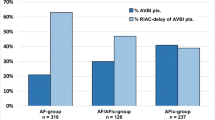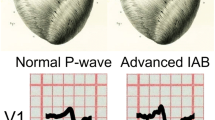Abstract
Background
Atrioventricular (AV) conduction disturbances have often been considered as an etiology of prolonged pauses during atrial fibrillation (AF). We aimed to test whether there was a significant difference in the AV conduction properties between patients with and without clinically significant pauses who underwent ablation of longstanding persistent AF.
Methods
Ninety-nine patients undergoing ablation of longstanding persistent AF were divided into three groups according to the extent of pauses documented on the ambulatory electrocardiogram during AF; patients without pauses (n = 25), with pauses of <3 s (n = 52), and with pauses of ≥3 s (n = 22). The AV conduction properties, heart rate variability, and bradycardia-related symptoms after conversion to sinus rhythm were compared across the three groups plus a control group (n = 35).
Results
Sinus conversion was achieved in all patients after ablation. No differences were found across the groups in the AV conduction properties including the AH and HV intervals, AV nodal effective refractory period, or Wenckebach point. A male gender (β = 0.32; p = 0.0016), structural heart disease (β = 0.24; p = 0.02), and the AA interval right after ablation (β = 0.35; p = 0.0014), rather than the AV conduction properties, were independent determinants of the longest normal RR interval during AF. No patients experienced any bradycardia-related symptoms after ablation.
Conclusions
No AV conduction abnormalities were necessarily identified after the ablation even among the patients suspected of having an AV conduction disturbance during AF.


Similar content being viewed by others
References
Mangrum, J. M., & DiMarco, J. P. (2000). The evaluation and management of bradycardia. The New England Journal of Medicine, 342, 703–709.
Epstein, A. E., DiMarco, J. P., Ellenbogen, K. A., Estes, N. A., 3rd, Freedman, R. A., Gettes, L. S., et al. (2008). American College of Cardiology/American Heart Association Task Force on Practice Guidelines (Writing Committee to Revise the ACC/AHA/NASPE 2002 Guideline Update for Implantation of Cardiac Pacemakers and Antiarrhythmia Devices); American Association for Thoracic Surgery; Society of Thoracic Surgeons. ACC/AHA/HRS 2008 Guidelines for Device-Based Therapy of Cardiac Rhythm Abnormalities: a report of the American College of Cardiology/American Heart Association Task Force on Practice Guidelines (Writing Committee to Revise the ACC/AHA/NASPE 2002 Guideline Update for Implantation of Cardiac Pacemakers and Antiarrhythmia Devices): developed in collaboration with the American Association for Thoracic Surgery and Society of Thoracic Surgeons. Circulation, 117, e350–e408.
Oral, H., Pappone, C., Chugh, A., Good, E., Bogun, F., Pelosi, F., Jr., et al. (2006). Circumferential pulmonary-vein ablation for chronic atrial fibrillation. The New England Journal of Medicine, 354, 934–941.
Hocini, M., Sanders, P., Deisenhofer, I., Jaïs, P., Hsu, L. F., Scavée, C., et al. (2003). Reverse remodeling of sinus node function after catheter ablation of atrial fibrillation in patients with prolonged sinus pauses. Circulation, 108, 1172–1175.
Calkins, H., Brugada, J., Packer, D. L., Cappato, R., Chen, S. A., Crijns, H. J., et al. (2007). HRS/EHRA/ECAS expert Consensus Statement on catheter and surgical ablation of atrial fibrillation: recommendations for personnel, policy, procedures and follow-up. A report of the Heart Rhythm Society (HRS) Task Force on catheter and surgical ablation of atrial fibrillation. European Heart Rhythm Association (EHRA); European Cardiac Arrhythmia Society (ECAS); American College of Cardiology (ACC); American Heart Association (AHA); Society of Thoracic Surgeons (STS). Heart Rhythm, 4, 816–861.
Brignole, M., Alboni, P., Benditt, D., Bergfeldt, L., Blanc, J. J., Bloch Thomsen, P. E., et al. (2001). Guidelines on management (diagnosis and treatment) of syncope. European Heart Journal, 22, 1256–1306.
Nault, I., Lellouche, N., Matsuo, S., Knecht, S., Wright, M., Lim, K. T., et al. (2009). Clinical value of fibrillatory wave amplitude on surface ECG in patients with persistent atrial fibrillation. Journal of Interventional Cardiac Electrophysiology, 26, 11–19.
Haïssaguerre, M., Sanders, P., Hocini, M., Hsu, L. F., Shah, D. C., Scavée, C., et al. (2004). Changes in atrial fibrillation cycle length and inducibility during catheter ablation and their relation to outcome. Circulation, 109, 3007–3013.
Sairaku, A., Nakano, Y., Oda, N., Makita, Y., Kajihara, K., Tokuyama, T., et al. (2011). How many electrical cardioversions should be applied for repetitive recurrences of atrial arrhythmias following ablation of persistent atrial fibrillation? Europace (in press).
Malik, M., et al. (1996). Heart rate variability: standards of measurement, physiological interpretation and clinical use. Task Force of the European Society of Cardiology and the North American Society of Pacing and Electrophysiology. Circulation, 93, 1043–1065.
Dhingra, R. C., Rosen, K. M., & Rahimtoola, S. H. (1973). Normal conduction intervals and responses in sixty-one patients using His bundle recording and atrial pacing. Chest, 64, 55–59.
Brignole, M., Menozzi, C., Bottoni, N., Gianfranchi, L., Lolli, G., Oddone, D., et al. (1995). Mechanisms of syncope caused by transient bradycardia and the diagnostic value of electrophysiologic testing and cardiovascular reflexivity maneuvers. The American Journal of Cardiology, 76, 273–278.
Asano, Y., Saito, J., Yamamoto, T., Uchida, M., Yamada, Y., Matsumoto, K., et al. (1995). Electrophysiologic determinants of ventricular rate in human atrial fibrillation. Journal of Cardiovascular Electrophysiology, 6, 343–349.
Meijler, F. L., Jalife, J., Beaumont, J., & Vaidya, D. (1996). AV nodal function during atrial fibrillation: the role of electrotonic modulation of propagation. Journal of Cardiovascular Electrophysiology, 7, 843–861.
Hayano, J., Sakata, S., Okada, A., Mukai, S., & Fujinami, T. (1998). Circadian rhythms of atrioventricular conduction properties in chronic atrial fibrillation with and without heart failure. Journal of the American College of Cardiology, 31, 158–166.
Jørgensen, P., Schäfer, C., Guerra, P. G., Talajic, M., Nattel, S., & Glass, L. (2002). A mathematical model of human atrioventricular nodal function incorporating concealed conduction. Bulletin of Mathematical Biology, 64, 1083–1099.
Liu, S., Olsson, S. B., Yang, Y., Hertervig, E., Kongstad, O., & Yuan, S. (2004). Concealed conduction and dual pathway physiology of the atrioventricular node. Journal of Cardiovascular Electrophysiology, 15, 144–149.
Gallagher, M. M., Guo, X. H., Poloniecki, J., & Camm, A. J. (2010). Ventricular pauses during atrial fibrillation predict relapse after electrical cardioversion: a prospective study. Pacing and Clinical Electrophysiology, 33, 934–938.
Friedman, H. S. (2004). Heart rate variability in atrial fibrillation related to left atrial size. The American Journal of Cardiology, 93, 705–709.
James, T. N. (2003). Structure and function of the sinus node, AV node and his bundle of the human heart: part II—function. Progress in Cardiovascular Diseases, 45, 327–360.
Mangin, L., Vinet, A., Pagé, P., & Glass, L. (2005). Effects of antiarrhythmic drug therapy on atrioventricular nodal function during atrial fibrillation in humans. Europace, 7(Suppl 2), 71–82.
van den Berg, M. P., Crijns, H. J., Haaksma, J., Brouwer, J., & Lie, K. I. (1994). Analysis of vagal effects on ventricular rhythm in patients with atrial fibrillation. Clinical Science (London), 86, 531–535.
Mazgalev, T. N., Garrigue, S., Mowrey, K. A., Yamanouchi, Y., & Tchou, P. J. (1999). Autonomic modification of the atrioventricular node during atrial fibrillation: role in the slowing of ventricular rate. Circulation, 99, 2806–2814.
Mischke, K., Zarse, M., Schmid, M., Gemein, C., Hatam, N., Spillner, J., et al. (2010). Chronic augmentation of the parasympathetic tone to the atrioventricular node: a nonthoracotomy neurostimulation technique for ventricular rate control during atrial fibrillation. Journal of Cardiovascular Electrophysiology, 21, 193–199.
Takahashi, Y., Jaïs, P., Hocini, M., Sanders, P., Rotter, M., Rostock, T., et al. (2006). Shortening of fibrillatory cycle length in the pulmonary vein during vagal excitation. Journal of the American College of Cardiology, 47, 774–780.
Pappone, C., Santinelli, V., Manguso, F., Vicedomini, G., Gugliotta, F., Augello, G., et al. (2004). Pulmonary vein denervation enhances long-term benefit after circumferential ablation for paroxysmal atrial fibrillation. Circulation, 109, 327–334.
Burstein, B., & Nattel, S. (2008). Atrial fibrosis: mechanisms and clinical relevance in atrial fibrillation. Journal of the American College of Cardiology, 51, 802–809.
Dobrzynski, H., Boyett, M. R., & Anderson, R. H. (2007). New insights into pacemaker activity: promoting understanding of sick sinus syndrome. Circulation, 115, 1921–1932.
Bernal, O., & Moro, C. (2006). Cardiac arrhythmias in women. Revista Española de Cardiología, 59, 609–618.
Taneja, T., Mahnert, B. W., Passman, R., Goldberger, J., & Kadish, A. (2001). Effects of sex and age on electrocardiographic and cardiac electrophysiological properties in adults. Pacing and Clinical Electrophysiology, 24, 16–21.
Fujimura, O., Yee, R., Klein, G. J., Sharma, A. D., & Boahene, K. A. (1989). The diagnostic sensitivity of electrophysiologic testing in patients with syncope caused by transient bradycardia. The New England Journal of Medicine, 321, 1703–1707.
Acknowledgment
The authors thank Miss Maki Hamada for her technical assistance for the analyses of the Holter ECGs and Mr. John Martin for his grammatical assistance.
Funding
This work was not supported by any external funding.
Conflict of interest
None declared.
Author information
Authors and Affiliations
Corresponding author
Rights and permissions
About this article
Cite this article
Sairaku, A., Nakano, Y., Oda, N. et al. Atrioventricular conduction properties in patients with prolonged pauses undergoing ablation of longstanding persistent atrial fibrillation: do pauses during atrial fibrillation matter?. J Interv Card Electrophysiol 34, 277–285 (2012). https://doi.org/10.1007/s10840-011-9656-z
Received:
Accepted:
Published:
Issue Date:
DOI: https://doi.org/10.1007/s10840-011-9656-z




